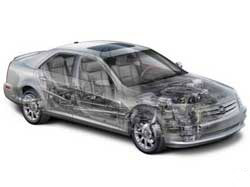
|
What is Can Bus?
The CAN Bus is an automotive bus developed by Robert Bosch, which has quickly gained acceptance into the automotive and aerospace industries. CAN is a serial bus protocol to connect individual systems and sensors as an alternative to conventional multi-wire looms. It allows automotive components to communicate on a single or dual-wire networked data bus up to 1Mbps.
|
Before CAN Bus
Since the early 1940's, automakers have continually improved their vehicles' technology by integrating an increasing amount of electronic components. As technology progressed, the vehicles became more complex as electronic components replaced mechanical systems and provided additional comforts, convenience, and safety features. Up until the release of CAN Bus, vehicles contained enormous amounts of wiring which was necessary to interconnect all of the various electronic components.
![[Vehicle Wiring: conventional mutli-wire looms]](/images/diag_canbus1.jpg)
Due to the vast amount of wiring, an after market installation requires the installer not only to understand how the integrated systems communicate with each other, but also requires numerous connections to be made throughout the vehicle. To make matters worse, the vehicle wiring differs between vehicle years, makes, and even models. As a result, installers need to be highly knowledgeable and perform intensive labor for the most trivial after market equipment or the installation shop experiences countless hours of lost time on troubleshooting and sometimes even expensive claims for damaged OEM equipment. During this progression, installation shops have had an increasingly difficult time finding qualified staff that are able to perform everyday installations and as a result, have either had to increase their prices to compensate for the required specialization and labor, or simply had to turn away the customers who owned complex vehicles.
Introducing CAN Bus
The BMW 850 coupe was the first CAN Bus vehicle to enter the market in 1986. By reducing the vehicles wiring by 2km, the vehicles overall weight was significantly reduced by at least 50kg and using only half the connectors. For the first time, each of the vehicles systems and sensors were able to communicate at very high speeds (25kbps - 1Mbps) on a single or dual-wire communication line as opposed to the previous multi-wire looms. However, the introduction of CAN Bus also increased the vehicles complexity and made after market installations even more difficult and in many cases impossible to perform.
![[Vehicle Wiring: CAN Bus network]](/images/diag_canbus2.jpg)
In 2006, over 70% of all automobiles sold in North America will utilize CAN Bus technology. Beginning in 2008, the Society of Automotive Engineers (SAE) requires 100% of the vehicles sold in the USA to use the CAN Bus communication protocol while the European Union has similar laws. Several new after market devices have been introduced into the market that utilize the CAN Bus protocol but until now, there have been no new devices that assist the aging after market remote starter and alarm system technology. Now there is an after market module that offers remote starter and alarm connectivity to the CAN Bus communication protocol.
The CAN SL is the first after market CAN Bus bypass kit to offer connectivity of aging remote starters and alarms to the new high speed CAN Bus communication protocol.
|
|

